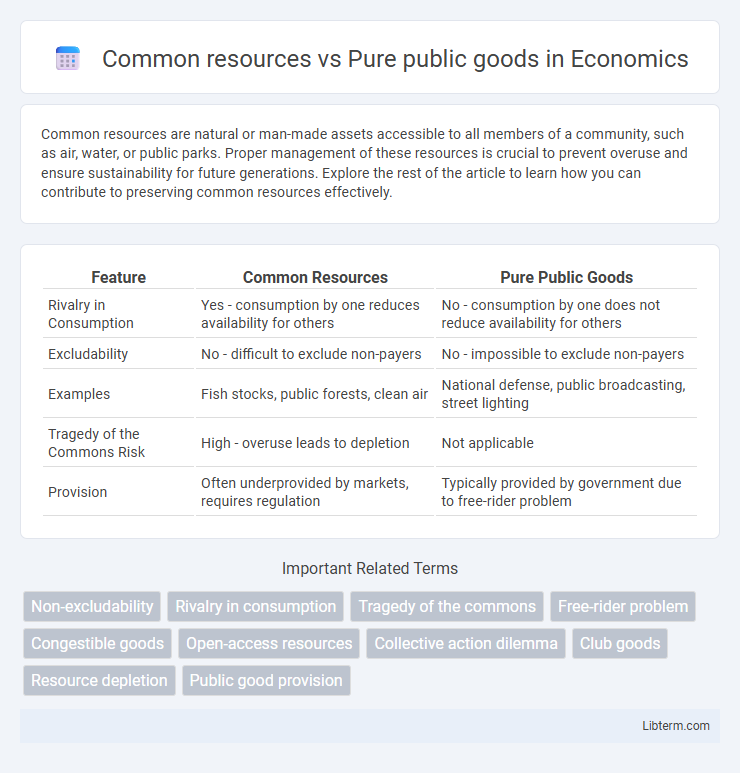Common resources are natural or man-made assets accessible to all members of a community, such as air, water, or public parks. Proper management of these resources is crucial to prevent overuse and ensure sustainability for future generations. Explore the rest of the article to learn how you can contribute to preserving common resources effectively.
Table of Comparison
| Feature | Common Resources | Pure Public Goods |
|---|---|---|
| Rivalry in Consumption | Yes - consumption by one reduces availability for others | No - consumption by one does not reduce availability for others |
| Excludability | No - difficult to exclude non-payers | No - impossible to exclude non-payers |
| Examples | Fish stocks, public forests, clean air | National defense, public broadcasting, street lighting |
| Tragedy of the Commons Risk | High - overuse leads to depletion | Not applicable |
| Provision | Often underprovided by markets, requires regulation | Typically provided by government due to free-rider problem |
Defining Common Resources and Pure Public Goods
Common resources are natural or man-made assets like fisheries, forests, and clean air that are rivalrous but non-excludable, meaning consumption by one individual reduces availability for others but access cannot be easily restricted. Pure public goods, such as national defense and public broadcasting, are characterized by being both non-rivalrous and non-excludable, allowing unlimited consumption by people without diminished availability for others. The key distinction lies in rivalry; common resources face depletion risks due to rivalry while pure public goods do not experience consumption rivalry.
Key Characteristics of Pure Public Goods
Pure public goods exhibit non-excludability and non-rivalry, meaning individuals cannot be prevented from using them, and one person's consumption does not reduce availability for others. Examples include national defense, clean air, and public broadcasting. These key characteristics create challenges in funding and provision since markets may fail to supply them efficiently.
Main Features of Common Resources
Common resources are rivalrous and non-excludable, meaning that one person's use reduces availability for others, while it is difficult to exclude others from accessing them. Examples include fisheries, groundwater basins, and forests, which are susceptible to overuse and depletion without effective management. Unlike pure public goods that are non-rivalrous and non-excludable, common resources require regulation to prevent the tragedy of the commons.
Differences Between Common Resources and Public Goods
Common resources are rivalrous but non-excludable, meaning consumption by one individual reduces availability for others, while pure public goods are both non-rivalrous and non-excludable, allowing unlimited consumption without depletion. Common resources often face overuse and depletion due to rivalry, whereas pure public goods do not suffer from congestion or exhaustion. The key difference lies in rivalry; common resources compete for access, while pure public goods provide shared benefits without diminishing availability.
Examples of Pure Public Goods
Pure public goods, such as national defense, clean air, and public fireworks displays, are characterized by their non-excludability and non-rivalrous consumption, meaning individuals cannot be prevented from using them, and one person's use does not diminish availability to others. These goods contrast with common resources like fisheries or groundwater, which are rivalrous but non-excludable, often leading to overuse or depletion. Examples of pure public goods highlight the necessity for government provision or collective financing to ensure efficient availability and consumption.
Examples of Common Resources
Common resources include fisheries, groundwater basins, and public grazing lands, characterized by non-excludability but rival consumption, leading to potential overuse. Unlike pure public goods such as national defense and clean air, common resources face depletion risks due to competitive consumption without effective ownership. Effective management strategies like quotas and property rights are essential to sustain common resources and prevent the tragedy of the commons.
The Free Rider Problem in Public Goods
Common resources, such as fisheries and forests, are rivalrous but non-excludable, leading to overuse and depletion, while pure public goods like national defense are non-rivalrous and non-excludable, creating challenges in funding and provision. The Free Rider Problem arises prominently with pure public goods since individuals can benefit without contributing, reducing incentives for voluntary payment and causing under-provision. Efficient management of these goods requires mechanisms like government intervention or collective agreements to ensure adequate supply and prevent resource exhaustion.
Tragedy of the Commons in Common Resources
Common resources, such as fisheries and grazing lands, are rivalrous but non-excludable, making them susceptible to overuse and depletion, a phenomenon known as the Tragedy of the Commons. Pure public goods, including national defense and public broadcasting, are both non-rivalrous and non-excludable, ensuring consumption by one individual does not reduce availability to others. The Tragedy of the Commons highlights the challenge in managing common resources sustainably without regulation or collective agreements to prevent resource depletion.
Strategies for Managing Common Resources
Common resources, unlike pure public goods, are rivalrous but non-excludable, requiring effective management strategies to prevent overuse and depletion. Implementing regulatory approaches such as quotas, licensing, and community-based management can help sustain common resource availability. Technological monitoring and incentivizing responsible usage further enhance the long-term stewardship of fisheries, forests, and grazing lands.
Policy Approaches for Pure Public Goods
Policy approaches for pure public goods prioritize non-excludability and non-rivalry characteristics, focusing on government provision and financing through taxation to address market failures. Efficient allocation mechanisms include direct regulation, public financing, and the use of subsidies to ensure universal access and optimal consumption levels. Emphasis on transparency and monitoring helps prevent free-riding problems and encourages sustained funding for essential services like national defense, clean air, and public broadcasting.
Common resources Infographic

 libterm.com
libterm.com